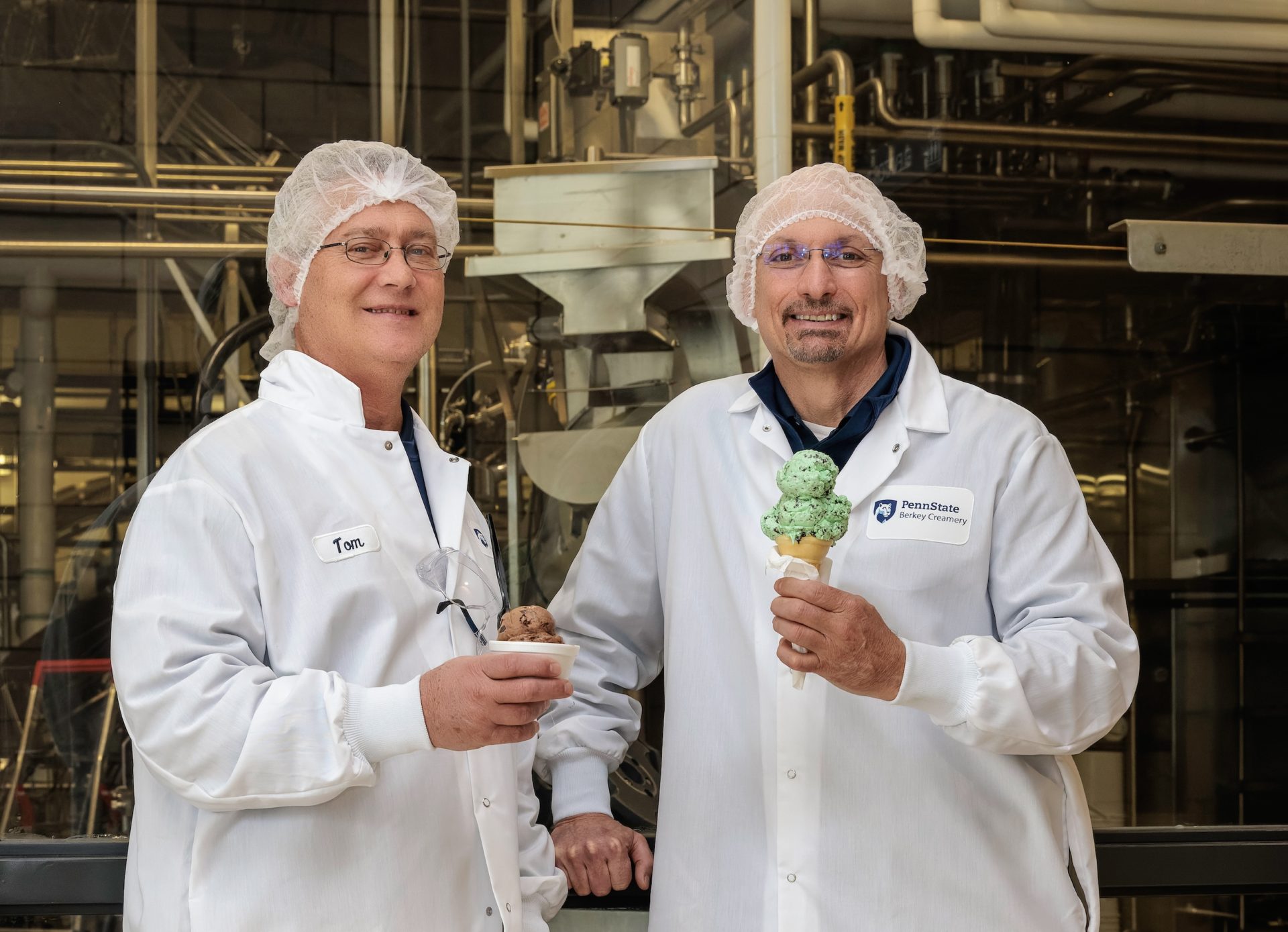Stepping inside Penn State’s Berkey Creamery is magical. Thomas R. Davis, Ph.D., the Creamery’s manager, says people compare it to Disney, “the happiest place on earth.”
“The store is,” Davis says. “But in the back, it’s a serious business. We’re a legitimate food company.”
By “the back,” Davis means Penn State’s Food Science Building, which is connected to the Creamery and is literally the “behind the scenes” site of the beloved store’s operations.
The Creamery serves more than a million customers every year, with 29 full-time employees and many student workers and interns. What started as a much smaller and simpler dairy operation in 1865 has expanded greatly and changed locations several times over the years.
“We always move closer and closer to the stadium and East Halls,” says Davis. “We want to get the students early and make it a tradition to come to the Creamery.”
All of the Creamery’s wholesale operations are on campus—in the dining halls and at convenience stores. They sell 125 different products with 450 SKUs (“stock keeping units,” the barcode on the back) and ship to all 48 continental United States.
“Over the years, we’ve created a lot of different products,” Davis says. “We’re a dairy plant imbedded inside an academic building. There are a lot of levels of complexity that most people don’t see and don’t understand.”
Jim Brown works alongside Davis as the Creamery’s sales and marketing manager to bring delicious concepts to the consumer. In recent years, the Creamery has expanded its drink offerings, with specialty coffee beverages and chocolate milk, the latter of which was named the best in the world at the 2021 World Dairy Expo Championship Dairy Product Contest. Other popular items include house-made dips and spreads, cheeses, Paw Power Packs (grab-and-go snack boxes), charcuterie kits, and ice cream sandwiches.
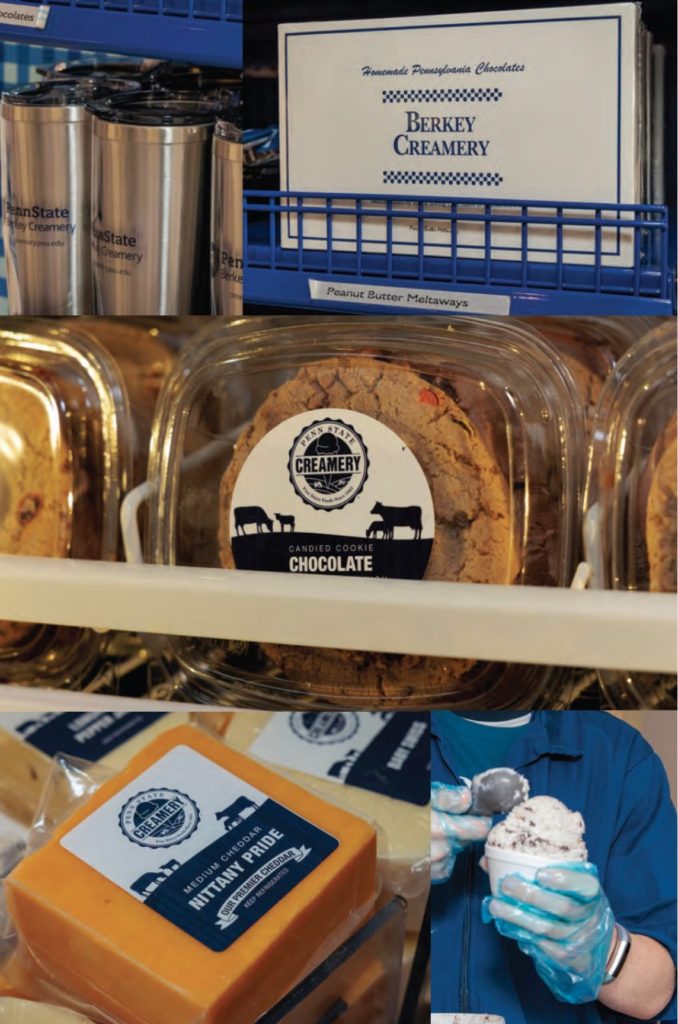
“Those are things we don’t actually manufacture in the plant—some components of them we might—but they get finished in the commissary,” Davis explains. “Ice cream is big for us, but our product development is much bigger than just ice cream.”
The commissary is Brown’s domain, and it’s where elements from various colleges at University Park come together (70 percent of the milk comes from Penn State’s dairy herds) to be readied for distribution at the Creamery. The cookies for the popular ice cream sandwiches, for instance, are created through a partnership with the on-campus bakery.
“We take all those products that we manufacture [like Creamery cheeses] and all those products that are across campus, like meats from the meats labs and so forth, and that’s how we partner and create finished products of different types of things,” says Brown. “The commissary is where we repackage and design a lot of products, run the store, and do e-commerce. We work with marketing interns, who create and develop products to sell in the store. We encourage our employees in e-commerce to come up with different ideas, too. We love empowering our students and employees.”
Because the Creamery’s operations are largely student-run, chances are pretty good that the product or flavor of ice cream you enjoy from the Creamery was a student’s idea.
“We reward initiative,” Brown says. “We like to see the students and employees who work for us come up with innovative ideas. A lot of them come to fruition.
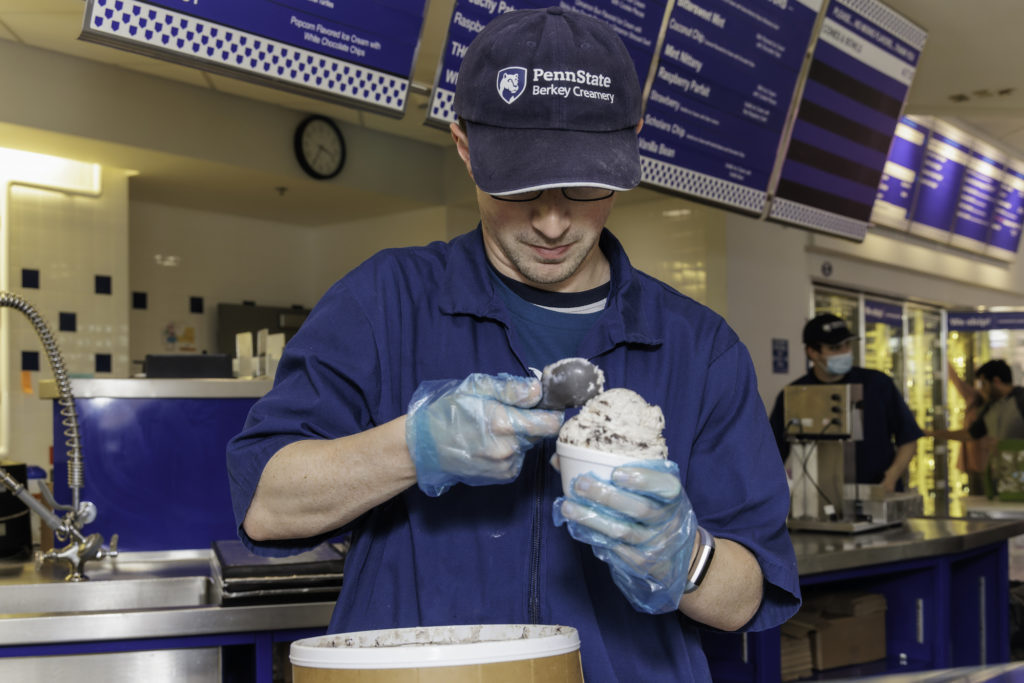
“Tom has a product development team made up of students and interns,” Brown continues. “Most of my employees are students and interns. I also have full-time people who are working in the store and in the commissary and e-commerce, and so forth, and those are where the ideas come from: when they hear things from customers. And we always encourage that, because we put our students in leadership roles. We call them student supervisors. And when you empower employees, you seem to get a lot more out of them when it comes to ideas. How do you develop new products, new flavors, etc.? It’s keeping up with the trends with the people who are right there on the front lines.”
Welcome to Flavortown
Though the Creamery is so much more than ice cream, the sweet, cold treat remains the most popular item. We’re talking 500,000-plus cones and bowls scooped a year and 200,000 half-gallons sold, with 10,000-plus half-gallons sold on an average home football game weekend alone.
“Ice cream’s the number one draw,” Brown says.
The Creamery maintains 14 “core flavors” that are always available (Death by Chocolate is the Creamery’s most popular flavor “by far”). There’s a second list of “favorites”—other, slightly less popular flavors that cycle in more often than the predominantly seasonal offerings. In total, throughout the year, the Creamery sells more than 100 flavors on a rotating schedule.
“Spring, early summer, late summer, we have it programmed!” Davis says.
When it comes to developing new ice cream flavors, there’s a lot to consider, Brown explains: “Do the flavor and product make sense? Will it be popular? Do we already have the ingredients to make it? If we don’t, does it make sense, cost-wise, to get it?”
An aspect of flavor offerings most people likely wouldn’t consider is space: with more than a million customers a year, and an impressively varied number of other products, storage is an issue.
“The Creamery has continued to become more and more popular,” Brown says. “We’re an iconic, traditional location. We now have generation after generation coming here; it’s a meeting place. What that caused, which is another good thing, is increased sales and increased demand. So as the increased demand came, there also came an increased demand for storage space—refrigeration, freezer space, storage space.”
Financial and space constraints mean not everyone will necessarily get their favorite flavor all the time. Sometimes vendors discontinue elements needed to create certain flavors. Other times, a flavor just isn’t popular enough to warrant its continuation.
“We’ve eliminated probably 50 flavors since I got here, as it makes business sense,” Davis says.
It turns out people get pretty possessive of their favorite ice cream flavors. Brown and Davis attest, for example, to quite the uproar from a group of local seniors devasted by the Creamery’s decision to pull Rum Raisin from the freezers.
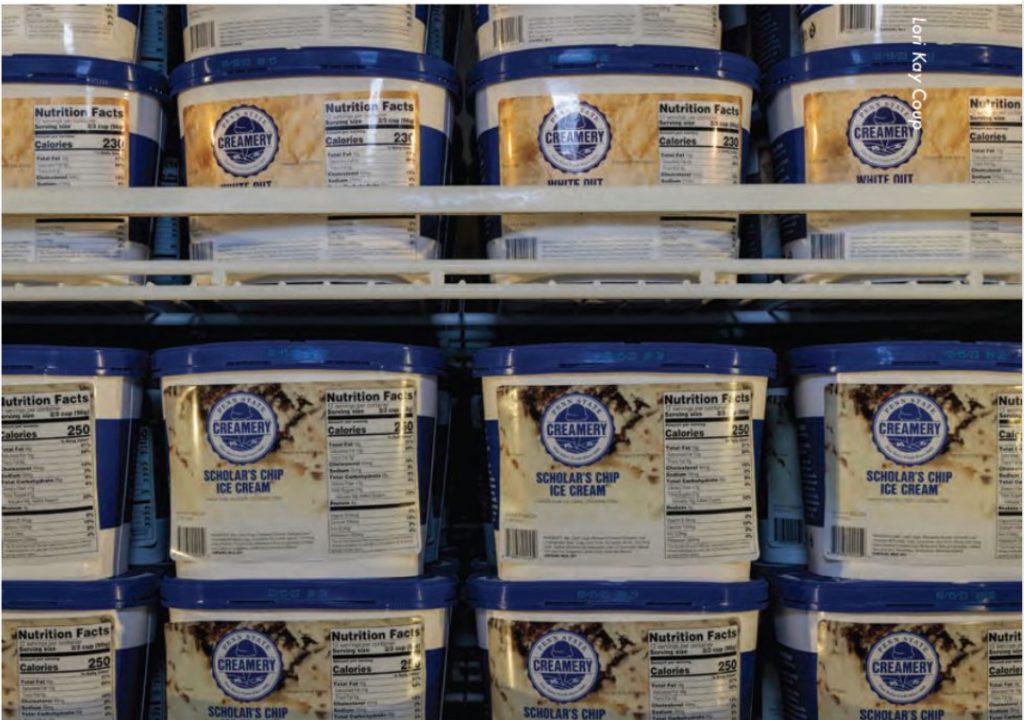
As some flavors lose their marketable value, though, others take their place. Teaberry, a uniquely central Pennsylvania flavor, has emerged recently as a surprise hit.
“The cult following is unbelievable,” Davis says.
“Teaberry is a huge regional thing that hasn’t died, and we’ve actually been able to grow that flavor and make more production runs of it,” says Brown. “It was our first flavor of spring. We only used to make it once a year. It’s refreshing both in the flavor and in its following, especially since I grew up with it.”
Creating and naming new ice cream flavors is not as straightforward a process as one might think. Some happen spontaneously, while others take months to bring to market.
The now-very-popular Monkey Business flavor came about when a vendor discontinued the variant it provided the Creamery for its old Bananas Foster-flavored ice cream.
“We needed something to do with this banana base that we had,” Davis recalls. “A guy in the back would stir peanut butter in it and chocolate chips. I tasted it and said, ‘Hey, that’s pretty good. I’m pretty sure we could sell a lot of that. We’re going to call it ‘monkey’ something. You can sell monkey anything to college kids.’”
Brown took the idea to the students, who created a survey with various names: Monkey See, Monkey Do, and so forth.
“The kids voted on it, and ‘Monkey Business’ won overwhelmingly,” Davis says. “In that instance, we had a need to use a product we didn’t want to throw away.”
Other times, flavors are born or named through what Brown refers to as the Flavor Sponsorship Program. Organizations, entities, colleges, and so forth will sometimes approach the Creamery and ask them to create or temporarily rename an ice cream to honor an event, celebration, anniversary, etc. Having the ability to make labels in-house has made this process easier, though some concepts take longer than others.
“We try to take a flavor and associate it with an iconic area of the university,” Davis says. “We always try to have an emotional tie to our products.”
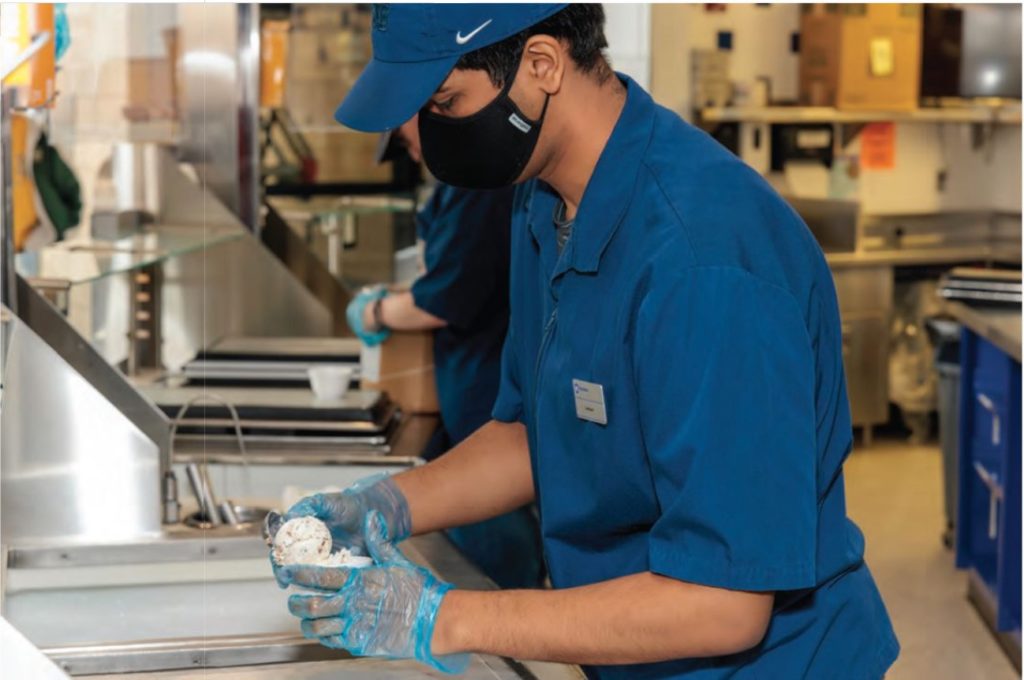
Brown and Davis note how the Creamery developed a special flavor ice cream to honor the annual White Out football game. The business school, Pink Zone, Bryce Jordan Center, and alumni association have sponsored flavors, too.
“THON asked us to develop a flavor for them,” Davis says. “It took about a year. Monkey Business took maybe ten minutes.”
The THON Committee, composed of students, requested their special flavor incorporate chocolate ice cream to represent the night sky, and white chocolate chips for the stars of sky. They asked for a golden ribbon, honoring the symbol for childhood cancer. The result is “chocolate ice cream laced with luscious caramel ribbon and white chocolate chips,” which the Creamery debuted at THON on the event’s opening day in 2018.
It’s true—Bill Clinton mixed flavors
There’s a legend around campus that then-President Bill Clinton mixed ice cream flavors during a 1996 visit to the Creamery—a big no-no.
It’s true (he mixed Cherry Quist and Peachy Paterno), but Brown explains:
“The president of the United States walks into a location, and you are a student serving ice cream. The rest is history. When [President Clinton] says, ‘I want this and this,’ you’re not even thinking about the rules and regulations of what you’re doing. Kind of intimidating, right? Realize, there’s only a few people in this store. There’s the president and secret service, an entourage of people in black suits with earbuds. There are no customers in the store. Just the president.”
Brown says that following the faux pas, they explained to the president the rule about choosing only one flavor, and “he was very understandable.”
“The second term when he came back, he did not mix flavors,” Davis adds with a laugh.
The reason for the single-flavor rule is simple, says Brown: for one thing, the Creamery is constantly hectic. For workers to be maneuvering behind the counter and bumping into each other, remembering people’s convoluted orders amid the “controlled chaos” would be difficult, to say the least.
“With 24 flavors out at a time, and with how busy we can get in here, can you imagine the number of different combinations you could do? Trying to put people through from an efficiency perspective would be a nightmare. But the most important reason is cross-contamination and allergens.”
If someone accidentally put the scooper used for Vanilla ice cream back in the Peanut Butter Swirl tub, for instance, something tragic could happen.
Thus, we’re left with only one choice: with so many flavors offered throughout the year and only one flavor allowed at a time, we’re forced to visit the Creamery, the Happiest Place in Happy Valley, as often as possible. T&G
Teresa Mull is a freelance writer who lives in Philipsburg. The Creamery’s coconut chip is her favorite ice cream in the world.
This story appears in the May 2022 issue of Town&Gown.
